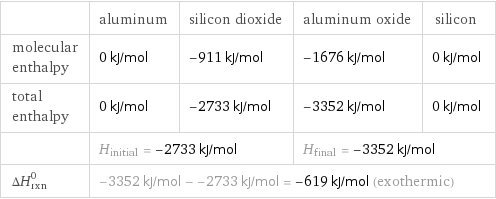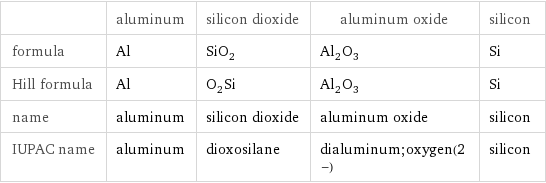Input interpretation

Al (aluminum) + SiO_2 (silicon dioxide) ⟶ Al_2O_3 (aluminum oxide) + Si (silicon)
Balanced equation

Balance the chemical equation algebraically: Al + SiO_2 ⟶ Al_2O_3 + Si Add stoichiometric coefficients, c_i, to the reactants and products: c_1 Al + c_2 SiO_2 ⟶ c_3 Al_2O_3 + c_4 Si Set the number of atoms in the reactants equal to the number of atoms in the products for Al, O and Si: Al: | c_1 = 2 c_3 O: | 2 c_2 = 3 c_3 Si: | c_2 = c_4 Since the coefficients are relative quantities and underdetermined, choose a coefficient to set arbitrarily. To keep the coefficients small, the arbitrary value is ordinarily one. For instance, set c_3 = 1 and solve the system of equations for the remaining coefficients: c_1 = 2 c_2 = 3/2 c_3 = 1 c_4 = 3/2 Multiply by the least common denominator, 2, to eliminate fractional coefficients: c_1 = 4 c_2 = 3 c_3 = 2 c_4 = 3 Substitute the coefficients into the chemical reaction to obtain the balanced equation: Answer: | | 4 Al + 3 SiO_2 ⟶ 2 Al_2O_3 + 3 Si
Structures

+ ⟶ +
Names

aluminum + silicon dioxide ⟶ aluminum oxide + silicon
Reaction thermodynamics
Enthalpy

| aluminum | silicon dioxide | aluminum oxide | silicon molecular enthalpy | 0 kJ/mol | -911 kJ/mol | -1676 kJ/mol | 0 kJ/mol total enthalpy | 0 kJ/mol | -2733 kJ/mol | -3352 kJ/mol | 0 kJ/mol | H_initial = -2733 kJ/mol | | H_final = -3352 kJ/mol | ΔH_rxn^0 | -3352 kJ/mol - -2733 kJ/mol = -619 kJ/mol (exothermic) | | |
Equilibrium constant
![Construct the equilibrium constant, K, expression for: Al + SiO_2 ⟶ Al_2O_3 + Si Plan: • Balance the chemical equation. • Determine the stoichiometric numbers. • Assemble the activity expression for each chemical species. • Use the activity expressions to build the equilibrium constant expression. Write the balanced chemical equation: 4 Al + 3 SiO_2 ⟶ 2 Al_2O_3 + 3 Si Assign stoichiometric numbers, ν_i, using the stoichiometric coefficients, c_i, from the balanced chemical equation in the following manner: ν_i = -c_i for reactants and ν_i = c_i for products: chemical species | c_i | ν_i Al | 4 | -4 SiO_2 | 3 | -3 Al_2O_3 | 2 | 2 Si | 3 | 3 Assemble the activity expressions accounting for the state of matter and ν_i: chemical species | c_i | ν_i | activity expression Al | 4 | -4 | ([Al])^(-4) SiO_2 | 3 | -3 | ([SiO2])^(-3) Al_2O_3 | 2 | 2 | ([Al2O3])^2 Si | 3 | 3 | ([Si])^3 The equilibrium constant symbol in the concentration basis is: K_c Mulitply the activity expressions to arrive at the K_c expression: Answer: | | K_c = ([Al])^(-4) ([SiO2])^(-3) ([Al2O3])^2 ([Si])^3 = (([Al2O3])^2 ([Si])^3)/(([Al])^4 ([SiO2])^3)](../image_source/2a229aafb85b0079a2f659ce5ecf6b83.png)
Construct the equilibrium constant, K, expression for: Al + SiO_2 ⟶ Al_2O_3 + Si Plan: • Balance the chemical equation. • Determine the stoichiometric numbers. • Assemble the activity expression for each chemical species. • Use the activity expressions to build the equilibrium constant expression. Write the balanced chemical equation: 4 Al + 3 SiO_2 ⟶ 2 Al_2O_3 + 3 Si Assign stoichiometric numbers, ν_i, using the stoichiometric coefficients, c_i, from the balanced chemical equation in the following manner: ν_i = -c_i for reactants and ν_i = c_i for products: chemical species | c_i | ν_i Al | 4 | -4 SiO_2 | 3 | -3 Al_2O_3 | 2 | 2 Si | 3 | 3 Assemble the activity expressions accounting for the state of matter and ν_i: chemical species | c_i | ν_i | activity expression Al | 4 | -4 | ([Al])^(-4) SiO_2 | 3 | -3 | ([SiO2])^(-3) Al_2O_3 | 2 | 2 | ([Al2O3])^2 Si | 3 | 3 | ([Si])^3 The equilibrium constant symbol in the concentration basis is: K_c Mulitply the activity expressions to arrive at the K_c expression: Answer: | | K_c = ([Al])^(-4) ([SiO2])^(-3) ([Al2O3])^2 ([Si])^3 = (([Al2O3])^2 ([Si])^3)/(([Al])^4 ([SiO2])^3)
Rate of reaction
![Construct the rate of reaction expression for: Al + SiO_2 ⟶ Al_2O_3 + Si Plan: • Balance the chemical equation. • Determine the stoichiometric numbers. • Assemble the rate term for each chemical species. • Write the rate of reaction expression. Write the balanced chemical equation: 4 Al + 3 SiO_2 ⟶ 2 Al_2O_3 + 3 Si Assign stoichiometric numbers, ν_i, using the stoichiometric coefficients, c_i, from the balanced chemical equation in the following manner: ν_i = -c_i for reactants and ν_i = c_i for products: chemical species | c_i | ν_i Al | 4 | -4 SiO_2 | 3 | -3 Al_2O_3 | 2 | 2 Si | 3 | 3 The rate term for each chemical species, B_i, is 1/ν_i(Δ[B_i])/(Δt) where [B_i] is the amount concentration and t is time: chemical species | c_i | ν_i | rate term Al | 4 | -4 | -1/4 (Δ[Al])/(Δt) SiO_2 | 3 | -3 | -1/3 (Δ[SiO2])/(Δt) Al_2O_3 | 2 | 2 | 1/2 (Δ[Al2O3])/(Δt) Si | 3 | 3 | 1/3 (Δ[Si])/(Δt) (for infinitesimal rate of change, replace Δ with d) Set the rate terms equal to each other to arrive at the rate expression: Answer: | | rate = -1/4 (Δ[Al])/(Δt) = -1/3 (Δ[SiO2])/(Δt) = 1/2 (Δ[Al2O3])/(Δt) = 1/3 (Δ[Si])/(Δt) (assuming constant volume and no accumulation of intermediates or side products)](../image_source/43a30bf36dc8aacac61a3728661b7786.png)
Construct the rate of reaction expression for: Al + SiO_2 ⟶ Al_2O_3 + Si Plan: • Balance the chemical equation. • Determine the stoichiometric numbers. • Assemble the rate term for each chemical species. • Write the rate of reaction expression. Write the balanced chemical equation: 4 Al + 3 SiO_2 ⟶ 2 Al_2O_3 + 3 Si Assign stoichiometric numbers, ν_i, using the stoichiometric coefficients, c_i, from the balanced chemical equation in the following manner: ν_i = -c_i for reactants and ν_i = c_i for products: chemical species | c_i | ν_i Al | 4 | -4 SiO_2 | 3 | -3 Al_2O_3 | 2 | 2 Si | 3 | 3 The rate term for each chemical species, B_i, is 1/ν_i(Δ[B_i])/(Δt) where [B_i] is the amount concentration and t is time: chemical species | c_i | ν_i | rate term Al | 4 | -4 | -1/4 (Δ[Al])/(Δt) SiO_2 | 3 | -3 | -1/3 (Δ[SiO2])/(Δt) Al_2O_3 | 2 | 2 | 1/2 (Δ[Al2O3])/(Δt) Si | 3 | 3 | 1/3 (Δ[Si])/(Δt) (for infinitesimal rate of change, replace Δ with d) Set the rate terms equal to each other to arrive at the rate expression: Answer: | | rate = -1/4 (Δ[Al])/(Δt) = -1/3 (Δ[SiO2])/(Δt) = 1/2 (Δ[Al2O3])/(Δt) = 1/3 (Δ[Si])/(Δt) (assuming constant volume and no accumulation of intermediates or side products)
Chemical names and formulas

| aluminum | silicon dioxide | aluminum oxide | silicon formula | Al | SiO_2 | Al_2O_3 | Si Hill formula | Al | O_2Si | Al_2O_3 | Si name | aluminum | silicon dioxide | aluminum oxide | silicon IUPAC name | aluminum | dioxosilane | dialuminum;oxygen(2-) | silicon